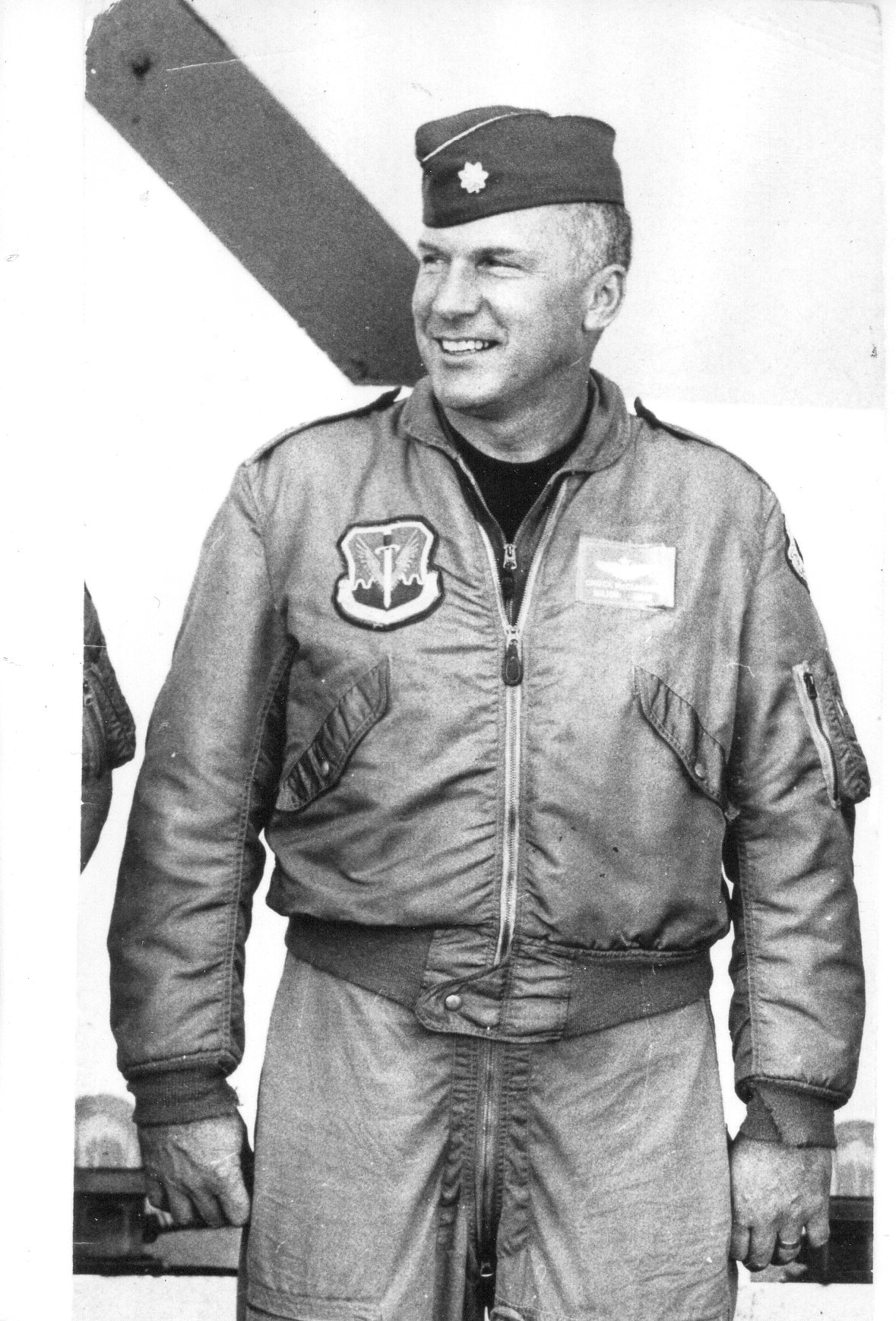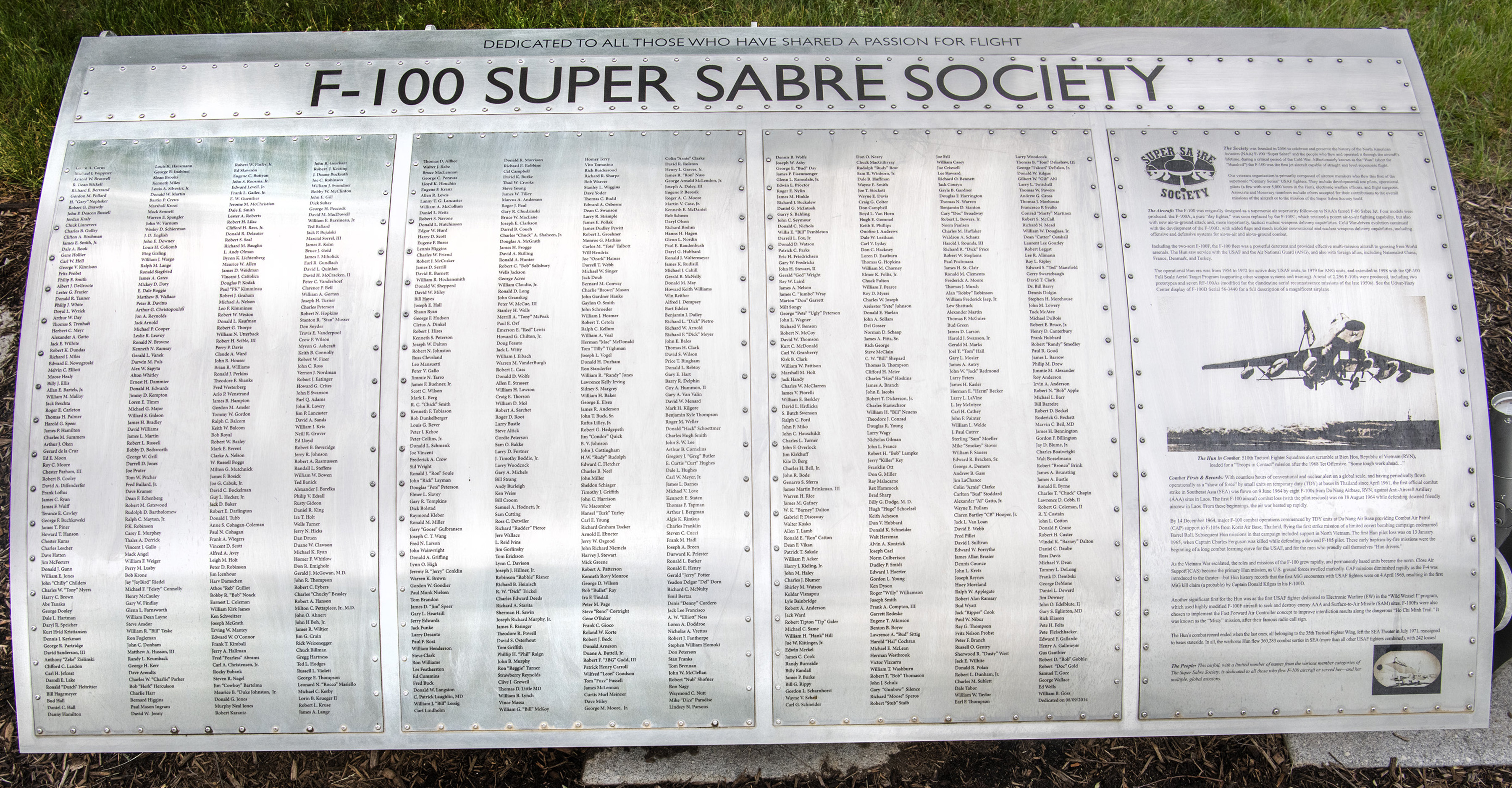
Foil: 10 Panel: F100 Super Sabre Society Column: 1 Line: 38
Wall of Honor Level: Air and Space Friend
Honored by:
CHARLES WILLIAM McCLARREN
- Born 26 July 1930
- Graduated Spencer High School 1948 - Senior class president, two years
varsity basketball
- Attended Purdue University 1948-1949 on academic scholarship
- Enlisted United States Air Force (USAF) on 13 November 1950.
- Completed electronics training Aug 51 and was retained at USAF Electronics
Center, Keesler AFB, Mississippi as instructor in radar repair courses.
- Had just been promoted to Staff Sergeant when was accepted into Aviation
Cadets, which began Aug 52.
- Graduated from officer and pilot training as Cadet Corp Commander and was
awarded the Jet Flying Award for outstanding achievement in academics,
military deportment and flying proficiency. Received pilot's wings and
commission as 2nd Lieutenant on same day.
- Completed fighter gunnery school/F-86 Sabre Jet training at Nellis AFB,
Nevada and was assigned to 390th Fighter Bomber Squadron at England AFB,
Louisiana in spring of 1954.
- Remained at England AFB for next five years as a primary duty fighter
pilot with secondary duties in aircraft maintenance and logistics. In
performing these duties, averaged 286 days per year on deployments to
locations all over the world. While on one of these deployments to Aviano
Air Base, Italy in early 1956, Lt. McClarren met his future wife, Marilyn
Joyce Buckley, whose father was in the American Consulate in Trieste. After
both had returned to the US later that year, they were married on 5 Aug 56.
- While at England AFB, upgraded pilot proficiency to F-84F Thunderstreak
and F-100 Super Sabres. Also was selected by his base to study Strategic
Air Command (SAC) procedures and modify them for use by Tactical Air Command
units. After spending a month with SAC at Bergstrom AFB, Texas, Lt.
McClarren returned to his home base and developed plans which completely
reorganized the wing into a centralized maintenance concept from the old
squadron methods. He personally created the unit manning documents and
equipment listings for each of the new organizations required, including a
consolidated aircraft maintenance squadron, an avionics maintenance squadron
and a wing quality control/aircraft flight test division. He subsequently
was selected to be the first quality control and flight test officer and
flew over 200 maintenance test flights in that capacity.
- In Oct 1958, Lt. McClarren was chosen to attend the USAF Fighter Weapons
Instructor Course at Nellis AFB, NV. (This was the Air Force "Top Gun"
school at that time.) Won "Top Gun" honors and was invited back as an
instructor in the school. Was promoted to Captain and remained at Nellis
AFB until July 61, when he was transferred overseas to Itazuke Air Base,
Japan as a flight commander in the 80th TFS.
- After one year in the squadron, was selected as wing Stan/Eval officer,
where he supervised the standardization of pilot procedures and evaluated
the in-flight performance of individual pilots as they accomplished the
various missions required of them to maintain combat readiness.
- Returned to the United States for three months during 1963 to check out in
the new F-105 Thunderchief Fighter Bomber. Upon return to Japan, was
assigned as Chief of the Wing Tactical Evaluation Team, which supervised the
wing's conversion to the new aircraft and re-attainment of combat readiness
in the new missions required. So thorough was this effort that the wing won
an Air Force Outstanding Unit Award for its exemplary performance in the
Operational Readiness Inspections which were accomplished to re-certify unit
combat readiness in the new airplanes. Major McClarren was recommended for
the Air Force Commendation Medal as a result of his leadership in this
effort.
- Shortly after the Gulf of Tonkin incidents of Aug 1964, Major McClarren?s
wing was ordered to send a squadron to Korat Air Base, Thailand, where they
would be available in case the situation heated up. He went with his
squadron and found himself in combat almost immediately after his arrival.
On his second mission over Laos, he was escorting an RF-101 on a photo recce
mission when it was shot down by enemy ground fire near Mugia Pass and the
North Vietnam border. Major McClarren remained over the bailout area, made
suppressive attacks on enemy gun positions and troops who were trying to get
to the downed pilot and organized a successful rescue operation which
included a USAF aerial refueling tanker, two Navy planes and an Air America
helicopter which finally recovered the badly injured RF-101 pilot almost
three hours after he was downed. Despite extensive injuries, he survived,
and Major McClarren was awarded the Distinguished Flying Cross for his
actions that day. This, incidentally, was the first DFC ever awarded to an
F-105 pilot for combat valor.
- Major McClarren returned to the United States in July 1965 and became an
instructor again in the USAF "Top Gun" school for F-105 pilots at Nellis
AFB, NV.
- He returned to Vietnam again for another F-105 combat tour in 1966, during
which he flew many more missions against heavily defended targets in the
Hanoi area of North Vietnam.
- Upon his return to Nellis AFB in late 1966, Major McClarren was selected
to head an Air Force Team which was to evaluate a new Navy attack fighter
(the A-7) for possible future Air Force procurement. The team consisted of
himself and two other pilots, a maintenance officer and 21 non-commissioned
officers who were maintenance specialists in aircraft systems. They moved
to NAS Lemoore, California, where they became working members of the first
Navy A-7 squadron. During the next two years they became combat ready,
carrier qualified and flew an eight month combat cruise aboard the USS
Ranger in the Gulf of Tonkin. Major McClarren picked up another 65 missions
over North Vietnam on this cruise as well as 124 carrier landings in all
types of day and night weather conditions. His ship was also redeployed to
the Sea of Japan for two months during the Pueblo Crisis. Many "firsts"
were recorded during this unusual tour of duty with the Navy, not the least
of which was that it was the first and only time that USAF enlisted men had
worked alongside their Navy counterparts during combat operations on a
carrier deck.
- Returning to Nellis AFB in 1968, Major McClarren found that his reports
and recommendations had been taken favorably by the Air Force, and
procurement of the USAF A-7D would begin in 1969. During the next two
years, he supervised the early operational testing and acceptance of the A-
7D aircraft into the Air Force's Tactical Air Command. He was promoted to
Lieutenant Colonel in 1970 and, fourteen months later, was promoted to the
Colonel three years ahead of his peers.
- In 1971, he was assigned to the office of Operational Testing and
Evaluation at USAF Headquarters in the Pentagon, where he remained for two
years before being sent to the Air War college at Maxwell AFB, Alabama, in
Sep 73. While in War College, Colonel McClarren finally was able to
complete his requirements for a degree and was awarded his B.S. in Social
Studies from Troy State University.
- Colonel McClarren's next assignment was as Deputy Wing Commander of the
famous "Flying Tigers", then based at England AFB, La. He served in this
position for six months and then became Wing Commander. In this capacity,
he was responsible for a base with over 5000 people, an annual budget of 128
million dollars and the combat readiness of four squadrons of A-7D aircraft.
- In January 1976, Colonel McClarren was reassigned to a NATO Command in
Europe, where he was Chief of Allied Offensive Air Operations for Central
Europe for two years.
- In 1978, Colonel McClarren was chosen to establish and head the first USAF
Liaison Office in RAF Strike Command Headquarters at High Wycombe, England.
For the next five years, he coordinated USAF/RAF affairs not only for Europe
but also during the Falklands War when he rendered much assistance to the
RAF operations in that extreme area. A token of RAF appreciation for
Colonel McClarren's work was when, near the end of his tour of duty with
them, he and his wife were invited to Buckingham Palace for tea with Queen
Elizabeth!
- Colonel McClarren retired from active duty on 1 November 1983 after 33
years of continuous service, ranging from the rank of Private to full
Colonel and seeing much of the world during that time. He and his wife
Joyce retired to, and passed, in Albuquerque, New Mexico.
- Among Colonel McClarren's many awards and decorations, he was most proud
of:
- Three Legions of Merit
- The Distinguished Flying Cross
- Nine Air Medals
- Three Navy Commendation Medals with Combat V's
- The Air Force Outstanding Unit Award
- The Navy Meritorious Unit Commendation
- The Combat Readiness Medal
- Air Force Good Conduct Meal
- Armed Force Expeditionary Medal
- Vietnam Service Medal with one Oak Leaf Cluster
- His and Joyce's personal invitation to Buckingham Palace
- His plaque from the RF-101 Squadron which thanks him for saving their pilot's life and ends,
"May God fly with you always."
Wall of Honor profiles are provided by the honoree or the donor who added their name to the Wall of Honor. The Museum cannot validate all facts contained in the profiles.
Foil: 10
